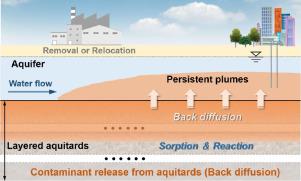Water Research ( IF 11.4 ) Pub Date : 2022-07-29 , DOI: 10.1016/j.watres.2022.118925 Xiang-Hong Ding 1 , Shi-Jin Feng 2 , Qi-Teng Zheng 1

|
Contaminants stored in the low permeability sediments will continue to threaten the adjacent shallow groundwater system after the aquifer is remediated. Understanding the storage and discharge behavior of contaminants in the aquitards is essential for the efficient remediation of contaminated sites, but most of the previous analytical studies focused on nonreactive solutes in a single homogenous aquitard. This study presents novel analytical solutions for the forward and back diffusion of contaminants through multi-layer low permeability sediments considering abiotic and biotic environmental degradation. Three representative source depletion patterns (i.e., instantaneous, linear, and exponential patterns) were selected to describe the dissolution of dense non-aqueous phase liquids (DNAPL) in the aquifer more realistically. At the forward diffusion stage, the mass storage of contaminants in the aquitards with the instantaneous pattern is the largest, nearly twice that with the exponential pattern. A simple equivalent homogeneous model is generally adopted in the risk assessment. However, relative to the proposed multi-layer model, it will significantly underestimate the onset of the back-diffusion of heterogeneous aquitards and overestimate the persistence of aquifer plumes. The previously-reported semi-infinite boundary assumption is also not applicable, with a maximum error of over 200% in the long-term prediction of back diffusion behavior of a thin aquitard. Moreover, when the degradation half-life is less than 16 years, less than 10% of the contaminants stored in the aquitards will diffuse into the overlying aquifer, suggesting that biostimulation or bioaugmentation can effectively mitigate back-diffusion risk. Overall, the proposed diffusion-reaction coupled model with multi-layer media is of great value and high demand in predicting the back-diffusion behavior of heterogeneous aquitards and guiding the soil bioremediation.
中文翻译:

活性污染物通过多层低渗透沉积物的正向和反向扩散
在含水层得到修复后,储存在低渗透沉积物中的污染物将继续威胁邻近的浅层地下水系统。了解污染物在隔水层中的储存和排放行为对于有效修复受污染场地至关重要,但之前的大多数分析研究都集中在单个均质隔水层中的非反应性溶质上。本研究提出了新的分析解决方案,用于考虑非生物和生物环境退化的污染物通过多层低渗透沉积物的正向和反向扩散。选择了三种具有代表性的源耗竭模式(即瞬时、线性和指数模式)来更真实地描述稠密非水相液体(DNAPL)在含水层中的溶解。在前向扩散阶段,瞬时模式的隔水层中污染物的大量储存量最大,几乎是指数模式的两倍。风险评估一般采用简单的等价齐次模型。然而,相对于所提出的多层模型,它将显着低估异质隔水层反扩散的开始,并高估含水层羽流的持久性。先前报道的半无限边界假设也不适用,在长期预测薄隔水层反扩散行为时最大误差超过 200%。此外,当降解半衰期小于 16 年时,储存在隔水层中的污染物只有不到 10% 会扩散到上覆含水层中,表明生物刺激或生物增强可以有效降低反向扩散风险。总体而言,所提出的具有多层介质的扩散-反应耦合模型对于预测非均质隔水层的反扩散行为和指导土壤生物修复具有重要价值和高要求。











































 京公网安备 11010802027423号
京公网安备 11010802027423号